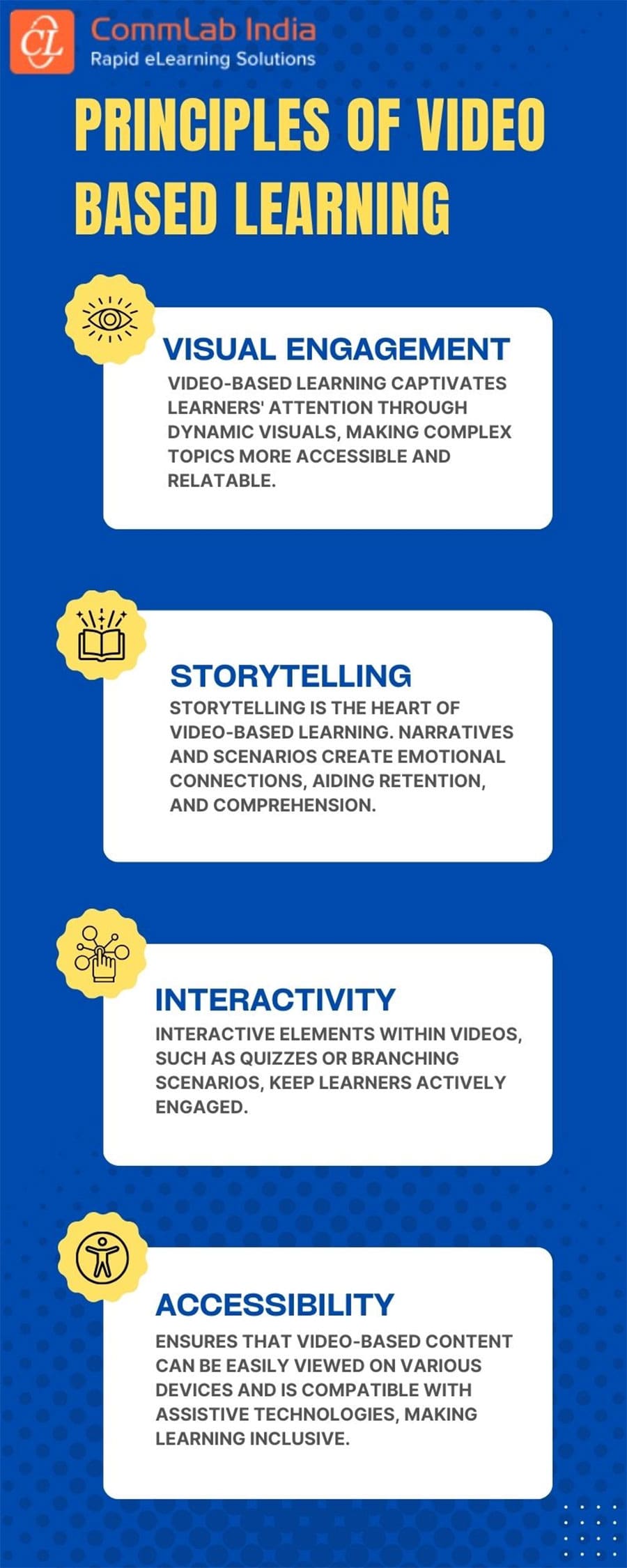4 Essential Principles to Master Video-based Learning [Infographic]
Want to turn your passive viewers into engaged learners? Video-based learning works magic. Discover its principles and make learning more dynamic.

Video-based learning is a great way to enable self-paced learning and a more amazing alternative to lengthy and monotonous training materials.
With its unique ability of self-paced learning, video-based learning puts learning at the fingertips of learners all over the world. It is now the beating heart of corporate training. The question now isn't whether to embrace it, but how to leverage its power. To get the most out of it, we need to have and implement effective principles.
4 Principles that Elevate Video-based Learning
1. Visual Engagement
Compelling visuals capture and retain learners' attention. It's all about transforming passive spectators into active participants by incorporating elements like graphics, animations, and illustrative visuals in the videos that not only enhance understanding but also make the learning experience enjoyable. In the realm of video-based learning, visuals have the power to convey complex concepts, evoke emotions, and stimulate curiosity, fostering a deeper connection. As a principle, visual engagement ensures that every video is dynamic and interactive to maximize comprehension and retention, making learning not just informative but truly immersive.
→ Download Now: Video-based Learning — Are You All Set to Explore its Magic? [Infographic]
2. Storytelling
The power of narrative to engage and inspire learners is impeccable. It's the art of weaving compelling stories within learning content, making concepts relatable and memorable. Storytelling with captivating narratives stimulates the imagination and facilitates a deeper understanding of the subject matter. Storytelling humanizes the learning experience, connecting learners on an emotional level, and imparting knowledge in a way that resonates and lingers in their minds. In video-based learning, it's the thread that binds information with context, fostering a dynamic, interactive, and unforgettable learning experience.
3. Interactivity
Learning isn't a one-way thing but a two-way exchange between the learner and the content. In video-based learning, interactivity is enabled through various formats like interactive videos, microlearning videos, and more and allows learners to make choices and explore various paths. This transforms passive viewers into engaged participants, fostering curiosity, critical thinking, and problem-solving skills. It's the driving force that keeps learners attentive and motivated. In essence, interactivity is the key to making video-based learning not just informative but truly transformative.
4. Accessibility
Learning content must be accessed and understood by all, regardless of physical or cognitive limitations. It's the commitment to creating content that is barrier-free, catering to diverse learners. In video-based learning, accessibility principles include providing closed captions, transcripts, and audio descriptions to accommodate those with hearing or vision impairments. It also means designing content that is navigable considering different learning styles and needs. Accessibility in video-based learning is crucial for creating an inclusive and empowering learning environment.
Your Next Step
From interactivity to accessibility, from storytelling to visual engagement, these principles are the building blocks of a winning video in learning. So, go forth and implement them and witness how your video-based learning supercharges.
Want to get started with video-based learning and leverage its power? Then here’s an amazing resource to help you learn about the why, how, and where of it. Download the infographic and delve into the charm of video-based learning!




![Video-based Learning — The Go-to Strategy for Modern Learners [Infographic]](https://no-cache.hubspot.com/cta/default/59327/01a6bcb1-79c8-44e5-ade9-be0c530d9ae3.png)


